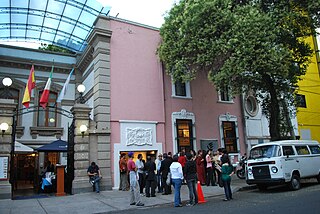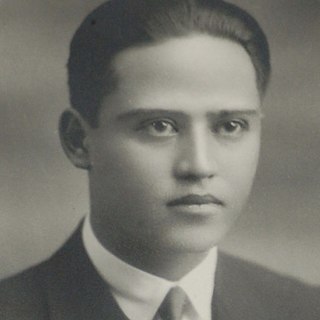
The National Autonomous University of Mexico is a public research university in Mexico. It is consistently ranked as one of the best universities in Latin America, where it's also the biggest in terms of enrollment. UNAM's main campus in Mexico City, known as Ciudad Universitaria, is a UNESCO World Heritage site that was designed by some of Mexico's best-known architects of the 20th century and hosted the 1968 Summer Olympic Games. Murals in the main campus were painted by some of the most recognized artists in Mexican history, such as Diego Rivera and David Alfaro Siqueiros. With acceptance rates usually below 10%, UNAM is also known for its competitive admission process. All Mexican Nobel laureates are either alumni or faculty of UNAM.

Juan O'Gorman was a Mexican painter and architect.

The Ibero-American University is a Mexican private institution of higher education, sponsored by the Society of Jesus. In 2009, the UIA received the SEP-ANUIES Prize as the best private university in Mexico. The Ibero's flagship campus is located in the Santa Fe district of Mexico City. It is ranked by QS World University Rankings as 701-750 worldwide and 7 in Mexico.

Ciudad Universitaria, Mexico, is the main campus of the National Autonomous University of Mexico (UNAM), located in Coyoacán borough in the southern part of Mexico City. Designed by architects Mario Pani and Enrique del Moral, it encloses the Olympic Stadium, about 40 faculties and institutes, the Cultural Center, an ecological reserve, the Central Library, and a few museums. It was built during the 1950s on an ancient solidified lava bed in Coyoacán called "El Pedregal" to replace the scattered buildings in downtown Mexico City where classes were given. It was completed in 1954 at a cost of approximately $25 million. At the time of its completion it was the largest single construction project in Mexico since the Aztecs. It was declared a World Heritage Site by UNESCO in 2007.

Roberto Montenegro Nervo was a painter, muralist and illustrator, who was one of the first to be involved in the Mexican muralism movement after the Mexican Revolution. His most important mural work was done at the former San Pedro and San Pablo monastery but as his work did not have the same drama as other muralists, such as Diego Rivera, he lost prominence in this endeavor. Most of his career is dedicated to illustration and publishing, portrait painting and the promotion of Mexican handcrafts and folk art.
Olga Costa was a painter and cultural promoter who immigrated to Mexico from Germany when she was twelve. She began to study art at the Academy of San Carlos but left after only three months to help support her family. However, she met her husband, artist José Chávez Morado during this time. Her marriage to him involved her in Mexico's cultural and intellectual scene and she began to develop her ability to paint on her own, with encouragement from her husband. She had numerous exhibitions of her work in Mexico, with her work also sent to be sold in the United States. She was also involved in the founding and development of various galleries, cultural societies and three museums in the state of Guanajuato. She received the Premio Nacional de Ciencias y Artes among others for her work.

Carlos Mérida was a Guatemalan artist who was one of the first to fuse European modern painting to Latin American themes, especially those related to Guatemala and Mexico. He was part of the Mexican muralism movement in subject matter but less so in style, favoring a non-figurative and later geometric style rather than a figurative, narrative style. Mérida is best known for canvas and mural work, the latter including elements such as glass and ceramic mosaic on major constructions in the 1950s and 1960s. One of his major works, 4000m2 on the Benito Juarez housing complex, was completely destroyed with the 1985 Mexico City earthquake, but a monument to it exists at another complex in the south of the city.
Latin American art is the combined artistic expression of South America, Central America, the Caribbean, and Mexico, as well as Latin Americans living in other regions.

José Chávez Morado was a Mexican artist who was associated with the Mexican muralism movement of the 20th century. His generation followed that of Diego Rivera, José Clemente Orozco and David Alfaro Siqueiros. Although Chávez Morado took classes in California and Mexico, he is considered to be mostly self-taught. He experimented with various materials, and was an early user of Italian mosaic in monumental works. His major works include murals at the Ciudad Universitaria, Secretaría de Comunicaciones y Transportes and Museo Nacional de Antropología in Mexico City as well as frescos at the Alhóndiga de Granaditas, which took twelve years to paint. From the 1940s on, he also worked as a cultural promoter, establishing a number of cultural institutions especially in his home state of Guanajuato including the Museo de Arte Olga Costa - José Chávez Morado, named after himself and his wife, artist Olga Costa.

Many of Mexico's older architectural structures, including entire sections of Pre-Hispanic and colonial cities, have been designated World Heritage sites for their historical and artistic significance. The country has the largest number of sites declared World Heritage Sites by UNESCO in the Americas.

Colegio de San Ildefonso, currently is a museum and cultural center in Mexico City, considered to be the birthplace of the Mexican muralism movement. San Ildefonso began as a prestigious Jesuit boarding school, and after the Reform War it gained educational prestige again as National Preparatory School. This school and the building closed completely in 1978, then reopened as a museum and cultural center in 1992. The museum has permanent and temporary art and archeological exhibitions in addition to the many murals painted on its walls by José Clemente Orozco, Fernando Leal, Diego Rivera and others. The complex is located between San Ildefonso Street and Justo Sierra Street in the historic center of Mexico City.

Salón de la Plástica Mexicana is an institution dedicated to the promotion of Mexican contemporary art. It was established in 1949 to expand the Mexican art market. Its first location was in historic center of the city but today it mostly operates out of a building in Colonia Roma. The institution is run by a membership of almost four hundred recognized artists and holds multiple exhibitions each year. Although it operates autonomously, it is part of the Instituto Nacional de Bellas Artes y Literatura.

Various types of visual arts developed in the geographical area now known as Mexico. The development of these arts roughly follows the history of Mexico, divided into the prehispanic Mesoamerican era, the colonial period, with the period after Mexican War of Independence, the development Mexican national identity through art in the nineteenth century, and the florescence of modern Mexican art after the Mexican Revolution (1910-1920).
Desiderio Hernández Xochitiotzin was a Mexican artist best known for his large-scale mural work inside the State Government Palace in the state of Tlaxcala, Mexico, the last large scale mural of the Mexican muralism movement.

Fernando Leal was one of the first painters to participate in the Mexican muralism movement starting in the 1920s. After seeing one of his paintings, Secretary of Education José Vasconcelos invited Leal to paint at the Escuela Nacional Preparatoria. The resulting work is Los danzantes de Chalma. Leal also painted a mural dedicated to Simón Bolívar at the Anfiteatro Bolivar, as well as religious murals such as those at the chapel dedicated to the Virgin of Guadalupe at the Basilica Villa in Tepeyac.
Daniel Manrique was a Mexican artist whose life and work mostly revolved around his home neighborhood of Tepito in Mexico City. He was born into a poor family, who did not support his artistic ambitions, but he maintained his Tepito identity despite. Manrique is best known for his mural work, which depicts the life and popular culture of poor urban neighborhoods such as Tepito, as well as aspects of Mexican and Latin American history since the Spanish conquest. Most of this work was done in Tepito as part of the program he founded called Tepito Arte Acá, but he also did murals in other countries such as Canada and Argentina. His work and the work of Tepito Arte Acá has been recognized by UNESCO, several universities, the Museo de Arte Moderno, CONACULTA, INBA and he was accepted into the Salón de la Plástica Mexicana.
Andrea Gómez y Mendoza was a Mexican graphic artist and muralist, a member of the Salón de la Plástica Mexicana.

Tomás Chávez Morado was an artist from Silao, Guanajuato, Mexico. He taught at public schools, the Instituto Nacional de Bellas Artes y Literatura, and the Escuela de Artes Plásticas at the Universidad de Guanajuato, where he served as the director of the School of Visual Arts. His civic installations include El Paraguas and the national shield carving displayed at the National Museum of Anthropology in Mexico City as well as 260 monumental eagle head sculptures marking the route of Hidalgo the Liberator. Homenajea UG a Tomás Chávez Morado Con Exposición Plástica. University of Guanajuato, 9 Dec. 2014. Web. 02 Nov. 2015. <http://www.ugto.mx/noticias/noticias/6668-homenajea-ug-a-tomas-chavez-morado-con-exposicion-plastica>.</ref> According to Mexican Life, Mexico's Monthly Review, the work of Chávez Morado "creates visions of typical life in the streets, images of people one might find in the markets, at the ferias or inside the tenement patios, with a thematic emphasis on love and the mother and child."
Beatriz Peschard Mijares is a Mexican architect. She founded the architecture firm Bernardi Peschard Arquitectura in 2000, focusing mostly on residential and corporate projects. Her designs, such as the AA315 House in Mexico City, use motifs from architects such as Mies van der Rohe. Many of Peschard’s projects, including the AA315 House, incorporate the surrounding landscape with a modernist architectural design. Peschard serves on the editorial board of Architectural Digest México.

Guillermo Peschard Delgado was an orthodontic dentist and academic. As a professor of dentistry at the Universidad Juárez del Estado de Durango, he helped found the university's School of Dentistry.















